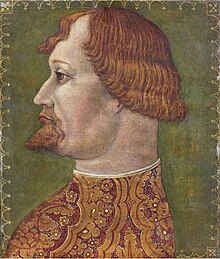Hours of Gian Galeazzo Visconti

The Hours of Giangaleazzo Visconti (Florence,
The Visconti Hours is a classic example of the personal prayer books of the period, which were generally made for wealthy lay persons.
The book remained unfinished until after Visconti's (and the dei Grassi's) death. It is now in the Biblioteca Nazionale in Florence.
Description
The pages are large in comparison to similar books, such as the
The pages are decorated in a distinctly Italian
History and commission
Production of this codex is attributed to Frate Amedeo; Amadeo signed his work, which was not typical of the time period. It was commissioned by Gian Galeazzo Visconti in the late 14th century, but only completed after his death at the request of his son Filippo Maria Visconti. The first artist commissioned was the master Italian illuminator Giovannino dei Grassi; after the latter’s death the work was completed by Luchino Belbello da Pavia.[citation needed]

Visconti was the first Duke of Milan and is accredited with creating the first modern bureaucracy due to the system of administration and programs he implemented, including a program of bookkeeping, "committing to books and ledgers the minutest items of his private expenditure and the outgoings of his public purse…"[5]
Artists
Giovannino dei Grassi
Born in Milan in about 1350, Giovannino dei Grassi was an Italian painter, sculptor, architect, and celebrated illuminator. He worked as an architect for the Milan Cathedral though he is better known for his works in illumination and painting. He is also well known for his notebook of drawings kept in the Library Angelo Mai of Bergamo. This notebook is considered one of the most important examples of late Gothic Italian art and consisted of scenes of daily activities, animals, and images from nature, as well as illuminated letters. He died in 1398.[citation needed]
Luchino Belbello da Pavia
Belbello da Pavia was an Italian miniaturist and painter active between approximately 1430 and 1470. His life and career remained mostly undetected until the beginning of the twentieth century when two scholars, Toesca and Pacchioni, identified him.[6] His style was influenced by the work of Giovannino dei Grassi, as well as that of Michelino da Besozzo. His contribution to the Offiziolo Visconti, the second half, is described primarily as an unusual chromatic fantasy.[citation needed]
Gallery
-
BR1: Marriage of Anna and Joachim
-
LF153: Foxes with Firebrands Judges 15
-
LF129v of the Visconti Hours
-
LF150v: Samson in battle
-
LF11v: Celestial Court
-
LF12: Fall of the Rebel Angels
-
LF155: Samson steals the gates of Gaza Judges 16
-
LF33v of the Visconti Hours
-
LF46v: Creation of Eve, attributed to Belbello da Pavia
References
- ISBN 978-0714834528.
- ISBN 978-3822847503.
- ^ "Visconti Book of Hours". FacsimileFinder. Retrieved 11 June 2017.
- ISBN 978-0807606513.
- ^ Symonds, John Addington (1888). Renaissance in Italy: The Age of Despots. New York: Henry Holt & Company. p. 142.
- ^ De Agostini, Novara (1964). "The Muses". 3: 155.
{{cite journal}}: Cite journal requires|journal=(help)










